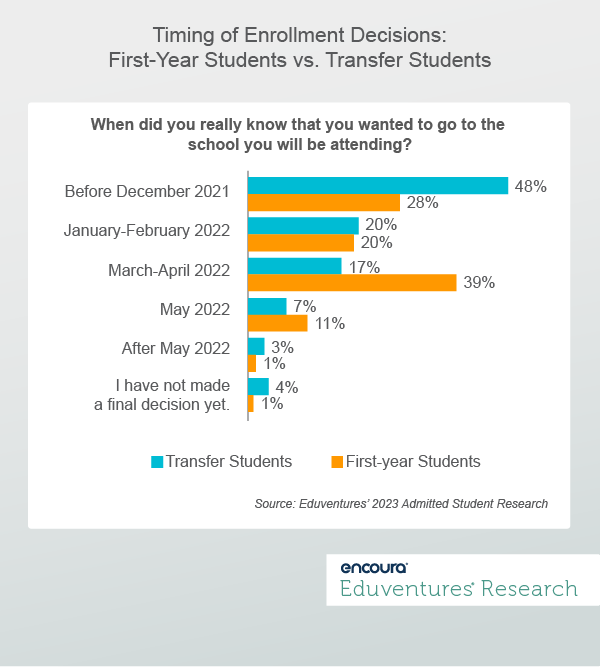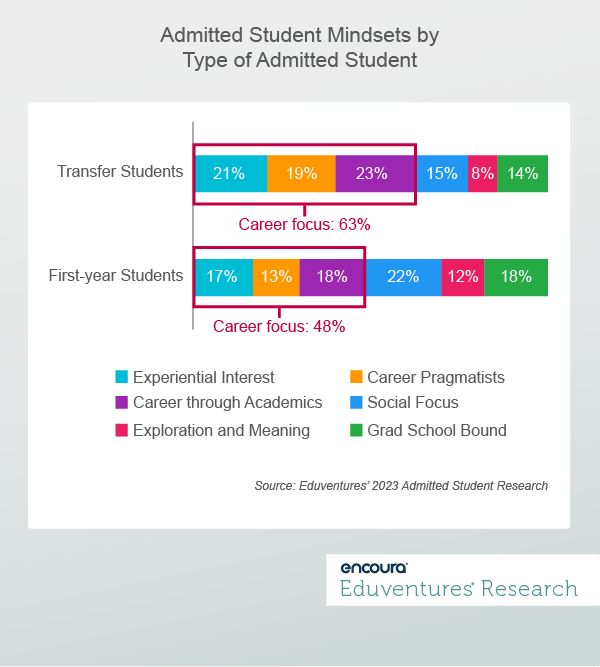June 14-16, 2023
Boston, MA
In fall 2022, first-year enrollment at community colleges increased by 6.1% over the previous year according to the National Student Clearinghouse. This marks the first increase in a longstanding annual decline.
While this news sparks hope, community college enrollment remains significantly below pre-pandemic levels. This not only causes difficulties for two-year schools, but also presents a challenge to four-year schools that rely on transfers to stabilize or boost enrollments.
. Yet, little is known about how and when these students make enrollment decisions.
An Easy Choice
Admitted student research has long been a staple of strategic enrollment planning. Understanding why students enroll or go elsewhere is an important prerequisite to crafting the right messaging, at the right time, to support decision making.
Surveys of admitted students, however, are primarily, and often exclusively, directed at college-bound high school seniors. Other audiences, such as transfer students, are often ignored entirely. Eduventures’ Admitted Student Research™, however, does include this important population.
In spring of 2022, 1,500 or 6% of our admitted student sample indicated they were transfer students. It is important to note that these students are traditional-aged transfer students rather than adult learners looking to return to higher education after stopping out. Additionally, transfer students in our sample may not exclusively consist of community college students (vertical transfers) but may also include those who plan to transfer out of a four-year college (horizontal transfers).
Including this audience in our sample allows us to draw important comparisons between the enrollment decision process of transfer students and that of first-year students. One important difference is the timing of their enrollment decisions (Figure 1).

Figure 1 shows that nearly half (48%) of all transfer students knew where they wanted to enroll before December of the previous year, compared to 28% of first-year students. This is particularly surprising considering that transfer application deadlines usually run later than those of first-time students. This means that transfer students not only make up their minds early but are also quite optimistic about their admissions chances—often making an enrollment choice before admissions decisions are communicated.
This sense of optimism is supported by the fact that transfer students apply to a smaller number of colleges, with an average of four college applications compared to an average of eight applications per first-time student. Transfers are also slightly more likely to say their enrollment schools are their first choices (88% compared to 84% of first-time students).
From Classroom to Career
These findings indicate that time and—more importantly, the right timing—is of the essence to capture the interests of transfers. The earlier an institution can capture a community college student’s attention with the right messaging, the better the odds the student will apply. But what is it that these vertical transfers are looking for in a college?
Figure 2 illustrates how the admitted Student Mindsets™ differ between transfer admits and first-year admits.

We can see that transfer admits most often fall into three Mindsets at higher rates than first-year students: Career Through Academics (23%), Experiential Interest (21%), and Career Pragmatists (19%)—all of which are characterized by a strong focus on career outcomes. This means that transfer admits want to see what the career preparation and outcomes at their enrollment schools will be. This is the primary message that institutions seeking to recruit these students will need to convey.
The student experience, the primary focus of students in Social Focus and Exploration and Meaning Mindsets, is less important to transfer admits than to first-year students. Institutions may not want to downplay the social and academic environments in messaging entirely—after all, they matter for a successful transfer experience. But the message institutions should lead with is one of successful career outcomes to capture transfer attention early.
The Bottom Line
Recruiting transfer students, particularly from the diminishing population of vertical transfers, is an important and growing focus of many four-year institutions, but many still struggle with specific messaging and recruitment strategies for this population. Here are some considerations for refining transfer recruitment strategies:
- The early institution catches the transfer student. Transfer students make enrollment decisions earlier than first-time students. In fact, Eduventures’ 2021 Transfer Student Research™ shows that a vast majority of prospective vertical transfers think about potential transfer schools before they enroll at their community colleges. This means that recruitment communication with these students can’t happen early enough. Staying in touch with first-year admits who ultimately choose two-year schools is critical.
- Career above all. Transfer admits show a greater focus on hard outcomes, particularly as they relate to their potential careers. These students are less focused on the campus community or small class sizes. They want to see proof that your institution will get them a desirable job and help them launch a long-term career. Recruitment outreach should focus on this key aspect along with messages around affordability, the latter of which will likely matter the most in the earliest stages of outreach.
Never Miss Your Wake-Up Call
Learn more about our team of expert research analysts here.
Eduventures Senior Analyst at Encoura
Contact
This recruitment cycle challenged the creativity of enrollment teams as they were forced to recreate the entire enrollment experience online. The challenge for this spring will be getting proximate to admitted students by replicating new-found practices to increase yield through the summer’s extended enrollment cycle.
By participating in the Eduventures Admitted Student Research, your office will gain actionable insights on:
- Nationwide benchmarks for yield outcomes
- Changes in the decision-making behaviors of incoming freshmen that impact recruiting
- Gaps between how your institution was perceived and your actual institution identity
- Regional and national competitive shifts in the wake of the post-COVID-19 environment
- Competitiveness of your updated financial aid model
Thursday, May 4, 2023, at 2pm ET/ 1pm CT
Over the past few years, graduate enrollment has continuously ticked upward growing by 12% between 2013 and 2021. However, based on National Student Clearinghouse estimates, fall 2022 brought us the first graduate enrollment decline in almost a decade. If graduate enrollment growth is no longer a guarantee, other market tensions—like increased program competition, proliferating non-degree programs, and a falling graduate enrollment rate—become much more acute challenges.
Join us for our upcoming webinar where Eduventures Senior Analyst Clint Raine will equip institutions with findings from the latest Eduventures Masters Market Update™ and successful master’s program innovation strategies.

